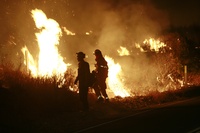Wildland Firefighter Safety: Resource Guide
 The first and highest call of a firefighter is the safety of those they are sworn to serve. To answer that call, it is essential that firefighters understand how to protect themselves so they can protect others.
The first and highest call of a firefighter is the safety of those they are sworn to serve. To answer that call, it is essential that firefighters understand how to protect themselves so they can protect others.
Nowhere is safety on the front lines a more urgent concern than on a wildfire. Ever-larger incidents -- fanned by swirling winds and whisking through drought-parched fuel -- can instantly transform an ordinary response into a life-threatening emergency.
Add to this the increased emphasis on structure protection, evacuation and rescue and California's wildlands become the most dangerous of work environments.
Knowing where you are, what's around you and how to protect yourself can prevent death or injury even in the most catastrophic events.
The pages on this site, culled from the forthcoming update of the CFFJAC's I-Zone program, offer information and principles that will help prevent injuries while fighting fires in the wildland-urban interface, as well as links to more detailed information.
These pages are intended as an overview of core techniques -- not a substitute for full Wildfire Safety Training
Fire Behavior Factors -- An overview of the variables beyond your control on the scene of a fire.
Human Behavior Factors -- An overview of the variables within your control as you respond with your company
High-Risk Tactics -- A rundown of the behaviors that put firefighters at greatest risk
Standard Orders and Watch Outs -- The basic "10s and 18s" -- 10 Standard Orders and 18 Watch-Outs
LCES -- A rundown of LCES and how to prepare for evacuation and emergency
Properly Refusing Risk -- You cannot be forced to take unreasonable safety risks.
Last Resort Survival-- What to do when there's no way out.
NWCG Pocket Guide -- A wildfire safety guide that can be printed out and kept handy at all times. From the National Wildfire Coordinating Group.